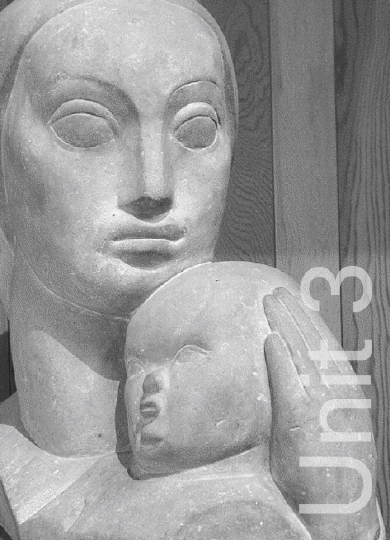UNIT 3A PORTRAYING RELATIONSHIPS
ABOUT THE UNIT
In this unit children investigate how paintings, prints, photographs and
other images that include figures communicate ideas about relationships. They
use composition skills to make a double portrait that conveys ideas about
themselves and their relationship with another person in their lives.
In the Ryan and Epstein images there seems to be a bond, a
closeness, a relationship between the figures (some of the sculptures in the
gallery put two heads together but they fail to relate).
The class works in groups of four – 2 draw whilst 2 pupils pose – face to
face, next to each other, one sitting/one standing, back to back, higher and
lower.
When looking at these images -
Discuss reasons for portraits e.g. school photos, team photos. Look for/cut
out photo from local newspaper showing two people – what does the relationship
seem to be /what does the text say about the relationship?
Ask pupils to discuss the relationship considering what it might be, how
close it is, how it is portrayed using elements such as composition, pose,
background, expressions, gestures and the relative sizes of the figures. Discuss
and comment on the different artistic approaches used – need for speed to
capture a pose or a personal moment, the purpose (for selling or to keep a
personal record of your family), and the status or relationship with the artist
(does it reveal anything of the artist’s attitudes, values, feelings?). These
double portraits give examples of different relationships mother and child,
married couple, big brother looking after little sister and couples dancing.
The unit requires pupils to make a painted double portrait of themselves and
another person in their lives. Prior to this explore groupings, using photos and
of scale.
• Some linear ink drawings (after Renoir/Millet) can be photocopied onto
acetate and enlarged with overhead projector onto large sheet of paper on wall
and drawn/painted life size.
Note how more intimate these more modern images are than the more formal
images produced long ago.
UNIT 3B INVESTIGATING PATTERN
ABOUT THE UNIT
In this unit children investigate patterns in textiles from different times
and cultures. They use ideas from these as a starting point for developing their
own designs. They investigate stencilling and print-making techniques and
explore ways of combining and organising shapes, colours and patterns to make a
decorative textile piece.
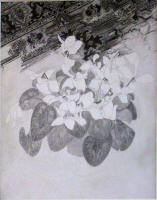
|
Alice Weldon ‘Cyclamen’ (pencil) GR358 (FLOWERS AND STILL LIFE) Discuss how this picture uses the traditional oriental pattern of the carpet
combined and contrasted with the natural forms and flowing lines of the cyclamen
leaves and petals. The petals are left blank and this may provide the basis of
an interesting drawing (i.e. drawing and shading the detail around an object
e.g. stool or chair which is left blank) with this simplifying useful for the
process of transferring observed shapes to a print process. Pupils could collect
examples of patterns (possibly including carpets from IKEA catalogue) and
research designs from other cultures, Indian printed textiles, Islamic tiles etc
and develop print ideas from these.
|
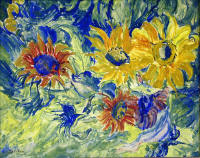
|
Jacob Epstein ‘Sunflowers’ (watercolours) GR69 (FLOWERS AND STILL LIFE) This is a bright, happy picture that appeals to younger pupils who enjoy
trying to paint the simple sunflower shapes with a blob of colour in the centre
and brushstroke petals radiating from it. After practice they can paint a
picture with various flower sizes, using a bright palette and a broad, lively
style. This idea can be developed into painting on fabric or into print ideas.
The print ideas can use the same shape in different colours or similar shapes in
varying sizes. The prints can press-print or stencil materials or ready-made
stencils available at ‘The Works’ bookshop in Walsall.
|
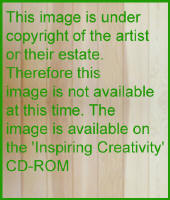
|
George Braque ‘Birds in Flight’ (lithograph) GR9 (ANIMALS AND BIRDS) This can provide inspiration of simple shapes to stencil using a stippling
brush or for a repeated pattern or possibly animation idea for the digital
media. Pupils can develop their own patterns based on their own animal ideas
(making them both simple and recognisable) after getting ideas by looking at 3D
animals during a gallery visit.
|
Various patterns used in different times and cultures can be used as
inspiration –
%20(a)%20-%20ca%2019th-20th%20C_small1.jpg)
%20(b)%20-%20ca%2019th-20th%20C_small1.jpg)
|
Ivory Coast ‘Heddle pulley from an upright loom’ (wood) GR332 (MAIN HALL) |
%20-%20Wood%20comb%20-%20ca%2019th-20th%20C_small2.jpg)
|
New Guinean ‘Comb’ (wood) GR331 (ILLUSTRATION AND SYMBOLISM) |
%20-%20Kuduo%20(gold%20dust)%20box%20the%20lid%20with%20motifs%20(b)_small.jpg)
|
Ghanaian (Ashante people) ‘Kuduo Box’ (bronze) GR329 (FLOWERS AND STILL LIFE) |
These 3 African examples are all very linear having zigzag or geometric
patterns that can be used for textiles or computer prints. The comb was in Jacob
Epstein’s original collection and a useful link is to the Entitlement Project
boxes which are available at the Walsall Schools Museum Service at the EDC,
Manor Farm, Rushall.
UNIT 3C CAN WE CHANGE PLACES?
ABOUT THE UNIT
In this unit children explore sculpture in public buildings and spaces. They
explore and use shape, form, colour and pattern to make a maquette or model of a
sculpture for a site in the school or the local area. They compare the ideas,
methods and approaches used in the work of different sculptors.
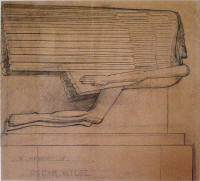
|
Jacob Epstein ‘Study for Tomb of Oscar Wilde’ (pencil) GR55 (ILLUSTRATION AND
SYMBOLISM)
The winged figures of a sphinx-like angel contrasts the lightness of the
flying figure with the heaviness of the plinth (see photograph in ‘A Shared
Vision’ page 28). This may be followed up by a visit to a cemetery in which
children explore use of sculpture to commemorate in public places. War memorials
are also a source of ideas. What would pupils commemorate? How? |
%20-%201907_small2.jpg)
|
Jacob Epstein ‘Maternity’ (pen and pencil) GR75 (FIGURE STUDIES) This is a sketch for a series of eighteen sculptures which portray the seven
ages of man designed for the British Medical Association building in London (see
photograph with babe in arms in ‘A Shared Vision’ page 27). This may be followed
up in various ways: looking at the ideas of commissions for public spaces, using
the different stages of life as a starting point for design-ideas. The
semi-naked pregnant woman caused hostile publicity and may be used for a debate
on taste.
|
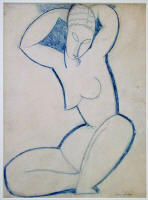
|
Amedeo Modigliani ‘Caryatid’ (pencil, blue crayon) GR170 (FIGURE STUDIES). A caryatid (rhymes with carry-a-kid) is a carved figure that acts as a pillar
supporting the roof of a Greek building. Many people I know count this picture
as their favourite image in the Garman-Ryan collection. It has a lively
simplicity with a mask-like face showing the influence of African and Eastern
Art. Pupils could be asked to design in relief a modern caryatid e.g. columns of
chips holding up a McDonalds (see work of Chapman brothers for combining African
and McDonalds images), giant belts and handbags for the leather museum, giant
pencils for the school.
|

|
Jacob Epstein ‘Maquette for Cavendish Square – Madonna and Child’ (lead) GR91
(RELIGIOUS ART) This could be used to look at the idea of using a maquette.
A small 3D idea which is used for planning and showing what final sculpture
will look like. (See books on Jacob Epstein to be found in The New Art Gallery
Library.)
|
%20-%20Eagle%20(Whalebone)%20(a)_small1.jpg)
%20-%20Eagle%20(Whalebone)%20(b)_small1.jpg)
|
Queen Charlotte Islands ‘Eagle’ (whale bone) GR322 (MAIN HALL) This sculpture is from the Haida people who had animals as their tribal
totems and made many stories and legends about them. They made sculptures which
are in the form of huge totem poles standing along the beaches of the North West
coast of the Queen Charlotte Islands, Canada. The villages could be recognised
by the totemic animal of the various tribal groups (this could be the eagle
clan). These are public sculptures for religious and recognition (like a
signpost) purposes. Pupils could combine their own likes into a totem pole
design and large work could be designed around cardboard rolls.
|
There are a range of public sculptures around Walsall town centre:
Sister
Dora, the Hippo, the Saddle,
the Spike (which has common local names that
re-occurred in census records) – emblematic of people of the borough.
The Water
Feature outside Tesco’s. These might be worth looking at and photographing to
consider ideas, methods and approaches of different sculptors to produce work
for public spaces. Keys mozaic and
Key in Willenhall.
Pelsall Millennium stone and Brownhill's
canals
The stripes design for the gallery square by Richard Wentworth (which is
carried on along the canal and also echoed in the metal seats he designed for
outside the gallery) unites the area outside the gallery with the angular forms
of the exterior and interior of the gallery. (See The New Art Gallery Walsall,
book about the building of The New Art Gallery, on sale in the Gallery Shop.)

Home |
A resource web for art teachers using the Garman Ryan Collection and the
New Art Gallery Walsall, England as a source of inspiration for the delivery of the QCA
National Curriculum 2000 art schemes of work to pupils in Key Stages 1-3 |
